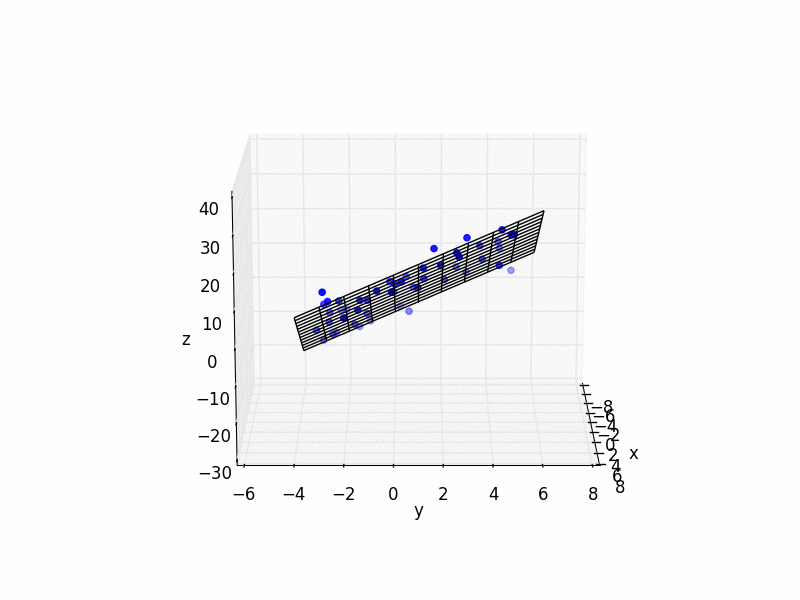3D最小二乘平面
给定一组3D数据点,在(x,y,z)空间中计算最小二乘平面的算法是什么?换句话说,如果我有一堆像(1,2,3),(4,5,6),(7,8,9)等点,那么如何计算最佳拟合平面f (x,y)= ax + by + c?从一组3D点中获取a,b和c的算法是什么?
9 个答案:
答案 0 :(得分:38)
如果你有n个数据点(x [i],y [i],z [i]),计算3x3对称矩阵A,其条目为:
sum_i x[i]*x[i], sum_i x[i]*y[i], sum_i x[i]
sum_i x[i]*y[i], sum_i y[i]*y[i], sum_i y[i]
sum_i x[i], sum_i y[i], n
还计算3元素向量b:
{sum_i x[i]*z[i], sum_i y[i]*z[i], sum_i z[i]}
然后解决给定A和b的Ax = b。解向量的三个分量是最小二乘拟合平面{a,b,c}的系数。
请注意,这是“普通最小二乘”拟合,仅当z预期为x和y的线性函数时才适用。如果你更普遍地寻找3空间中的“最佳平面”,你可能想要了解“几何”最小二乘法。
另请注意,如果您的点在一行中,则会失败,因为您的示例点是。
答案 1 :(得分:5)
除非有人告诉我如何在这里输入方程式,否则让我写下你必须做的最终计算:
首先,给定点r_i \ n \ R,i = 1..N,计算所有点的质心:
r_G = \frac{\sum_{i=1}^N r_i}{N}
然后,计算法向量n,它与基本向量r_G一起通过计算3x3矩阵A来定义平面
A = \sum_{i=1}^N (r_i - r_G)(r_i - r_G)^T
使用此矩阵,法线向量n现在由A的特征向量给出,对应于A的最小特征值。
要了解特征向量/特征值对,请使用您选择的任何线性代数库。
此解决方案基于Hermitian矩阵A的Rayleight-Ritz定理。
答案 2 :(得分:4)
参见'最小二乘拟合数据'大卫·埃伯利(David Eberly)就我如何想出这个来最小化几何拟合(从点到平面的正交距离)。
bool Geom_utils::Fit_plane_direct(const arma::mat& pts_in, Plane& plane_out)
{
bool success(false);
int K(pts_in.n_cols);
if(pts_in.n_rows == 3 && K > 2) // check for bad sizing and indeterminate case
{
plane_out._p_3 = (1.0/static_cast<double>(K))*arma::sum(pts_in,1);
arma::mat A(pts_in);
A.each_col() -= plane_out._p_3; //[x1-p, x2-p, ..., xk-p]
arma::mat33 M(A*A.t());
arma::vec3 D;
arma::mat33 V;
if(arma::eig_sym(D,V,M))
{
// diagonalization succeeded
plane_out._n_3 = V.col(0); // in ascending order by default
if(plane_out._n_3(2) < 0)
{
plane_out._n_3 = -plane_out._n_3; // upward pointing
}
success = true;
}
}
return success;
}
定时37 微秒将飞机拟合到1000点(Windows 7,i7,32位程序)

答案 3 :(得分:3)
与任何最小二乘方法一样,您可以这样继续:
开始编码之前
-
在某些参数化中记下平面的等式,比如
0 = ax + by + z + d在参数(a, b, d)中。 -
找到距离任意点
D(\vec{v};a, b, d)的距离\vec{v}的表达式。 -
记下总和
S = \sigma_i=0,n D^2(\vec{x}_i),然后进行简化,直到用v\sigma v_x\sigma v_y^2\sigma v_x*v_zdS/dx_0 = 0的成分的简单总和表示。 {1}} ... -
记下每个参数最小化表达式
dS/dy_0 = 0,{{1}} ...它为您提供了三个参数中的三个方程组以及上一步的总和。 -
解决这组参数的方程式。
- 编写代码以形成所需的总和,并从上一组中找到参数。
(或者对于简单的情况,只需查看表单)。使用符号代数包(如Mathematica)可以让您的生活更轻松。
编码
替代
请注意,如果你实际上只有三个点,那么你最好找到经过它们的飞机。
此外,如果分析解决方案不可行(不是飞机的情况,但一般情况下可能),您可以执行步骤1和2,并在步骤3中对总和使用Monte Carlo minimizer。
答案 4 :(得分:2)
CGAL::linear_least_squares_fitting_3
函数linear_least_squares_fitting_3计算最佳拟合3D 一组3D对象的线或平面(在最小二乘意义上) 作为点,段,三角形,球体,球,长方体或四面体。
答案 5 :(得分:1)
平面的等式是:ax + by + c = z。因此,使用您的所有数据设置这样的矩阵:
x_0 y_0 1
A = x_1 y_1 1
...
x_n y_n 1
和
a
x = b
c
和
z_0
B = z_1
...
z_n
换句话说:Ax = B.现在求解x是你的系数。但是因为(我假设)你有超过3个点,系统是超定的,所以你需要使用左伪逆。所以答案是:
a
b = (A^T A)^-1 A^T B
c
以下是一些带有示例的简单Python代码:
import matplotlib.pyplot as plt
from mpl_toolkits.mplot3d import Axes3D
import numpy as np
N_POINTS = 10
TARGET_X_SLOPE = 2
TARGET_y_SLOPE = 3
TARGET_OFFSET = 5
EXTENTS = 5
NOISE = 5
# create random data
xs = [np.random.uniform(2*EXTENTS)-EXTENTS for i in range(N_POINTS)]
ys = [np.random.uniform(2*EXTENTS)-EXTENTS for i in range(N_POINTS)]
zs = []
for i in range(N_POINTS):
zs.append(xs[i]*TARGET_X_SLOPE + \
ys[i]*TARGET_y_SLOPE + \
TARGET_OFFSET + np.random.normal(scale=NOISE))
# plot raw data
plt.figure()
ax = plt.subplot(111, projection='3d')
ax.scatter(xs, ys, zs, color='b')
# do fit
tmp_A = []
tmp_b = []
for i in range(len(xs)):
tmp_A.append([xs[i], ys[i], 1])
tmp_b.append(zs[i])
b = np.matrix(tmp_b).T
A = np.matrix(tmp_A)
fit = (A.T * A).I * A.T * b
errors = b - A * fit
residual = np.linalg.norm(errors)
print "solution:"
print "%f x + %f y + %f = z" % (fit[0], fit[1], fit[2])
print "errors:"
print errors
print "residual:"
print residual
# plot plane
xlim = ax.get_xlim()
ylim = ax.get_ylim()
X,Y = np.meshgrid(np.arange(xlim[0], xlim[1]),
np.arange(ylim[0], ylim[1]))
Z = np.zeros(X.shape)
for r in range(X.shape[0]):
for c in range(X.shape[1]):
Z[r,c] = fit[0] * X[r,c] + fit[1] * Y[r,c] + fit[2]
ax.plot_wireframe(X,Y,Z, color='k')
ax.set_xlabel('x')
ax.set_ylabel('y')
ax.set_zlabel('z')
plt.show()
答案 6 :(得分:1)
这会减少Total Least Squares问题,可以使用SVD分解来解决。
使用OpenCV的C ++代码:
float fitPlaneToSetOfPoints(const std::vector<cv::Point3f> &pts, cv::Point3f &p0, cv::Vec3f &nml) {
const int SCALAR_TYPE = CV_32F;
typedef float ScalarType;
// Calculate centroid
p0 = cv::Point3f(0,0,0);
for (int i = 0; i < pts.size(); ++i)
p0 = p0 + conv<cv::Vec3f>(pts[i]);
p0 *= 1.0/pts.size();
// Compose data matrix subtracting the centroid from each point
cv::Mat Q(pts.size(), 3, SCALAR_TYPE);
for (int i = 0; i < pts.size(); ++i) {
Q.at<ScalarType>(i,0) = pts[i].x - p0.x;
Q.at<ScalarType>(i,1) = pts[i].y - p0.y;
Q.at<ScalarType>(i,2) = pts[i].z - p0.z;
}
// Compute SVD decomposition and the Total Least Squares solution, which is the eigenvector corresponding to the least eigenvalue
cv::SVD svd(Q, cv::SVD::MODIFY_A|cv::SVD::FULL_UV);
nml = svd.vt.row(2);
// Calculate the actual RMS error
float err = 0;
for (int i = 0; i < pts.size(); ++i)
err += powf(nml.dot(pts[i] - p0), 2);
err = sqrtf(err / pts.size());
return err;
}
答案 7 :(得分:0)
你所要做的就是解决方程组。
如果这些是你的观点: (1,2,3),(4,5,6),(7,8,9)
这给你方程:
3=a*1 + b*2 + c
6=a*4 + b*5 + c
9=a*7 + b*8 + c
所以你的问题实际应该是:我如何解决方程组?
因此,我建议阅读this SO问题。
如果我误解了你的问题,请告诉我们。
修改:
忽略我的回答,因为你可能意味着别的东西。
答案 8 :(得分:0)
听起来你要做的就是用2个回归量进行线性回归。关于这个主题的wikipedia page应该告诉你所有你需要知道的事情,然后是一些。
- 我写了这段代码,但我无法理解我的错误
- 我无法从一个代码实例的列表中删除 None 值,但我可以在另一个实例中。为什么它适用于一个细分市场而不适用于另一个细分市场?
- 是否有可能使 loadstring 不可能等于打印?卢阿
- java中的random.expovariate()
- Appscript 通过会议在 Google 日历中发送电子邮件和创建活动
- 为什么我的 Onclick 箭头功能在 React 中不起作用?
- 在此代码中是否有使用“this”的替代方法?
- 在 SQL Server 和 PostgreSQL 上查询,我如何从第一个表获得第二个表的可视化
- 每千个数字得到
- 更新了城市边界 KML 文件的来源?
